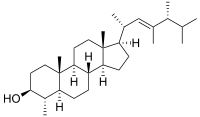Dinosterol
Dinosterol is a type of steroid produced by several genera of dinoflagellates. It is a 4α-methyl sterol (4α,23,24-trimethyl-5α-cholest-22E-en-3β-ol), a derivative of dinosterane, rarely found in other classes of protists.[1]
 | |
| Names | |
|---|---|
| IUPAC name
(3β,4α,5α,22E)-4,23-Dimethylergost-22-en-3-ol | |
| Identifiers | |
3D model (JSmol) |
|
| ChemSpider | |
PubChem CID |
|
| UNII | |
| |
| |
| Properties | |
| C30H52O | |
| Molar mass | 428.745 g·mol−1 |
Except where otherwise noted, data are given for materials in their standard state (at 25 °C [77 °F], 100 kPa). | |
| Infobox references | |
This sterol and others have been considered as class-specific, being biomarkers for dinoflagellates, although dinosterol is produced in minor amounts by a small number of other phytoplankton, such as the marine diatom Navicula speciosa.[2] and Prymnesiophytes of the genus Pavlova.[3]
Dinosterols show similar abundances as dinocysts.[4] Other studies found a nonlinear [5] or did not find a direct link between dinocyst abundances and sterol concentrations.[6]
Dinosterol has been used as indicator for dinoflagellate production in the Cariaco Basin.[7][8]
Hydrogen isotope ratios in dinosterols can serve to reconstruct salinity semi-quantitatively.[9]
Some studies have shown that certain dinoflagellates produce sterols that have the potential to serve as genera-specific biomarkers.[10][11] Recent work showed that dinoflagellate genera, which formed discrete clusters in the 18S rDNA-based phylogeny, shared similar sterol compositions. This suggested that the sterol compositions of dinoflagellates are explained by the evolutionary history of this lineage.[12]
References
- Volkman, J.K. (2003). "Sterols in microorganisms". Appl. Microbiol. Biotechnol. 60 (5): 495–506. doi:10.1007/s00253-002-1172-8. PMID 12536248.
- J.K. Volkman; S.M. Barrett; G.A. Dunstan; S.W. Jeffrey (1993). "Geochemical significance of the occurrence of dinosterol and other 4-methyl sterols in a marine diatom". Organic Geochemistry. 20: 7–15. doi:10.1016/0146-6380(93)90076-N.
- Volkman, P. Kearney, S.W. Jeffrey (1990). "A new source of 4-methyl sterols and 5[alpha](H)-stanols in sediments: prymnesiophyte microalgae of the genus Pavlova". Organic Geochemistry. 15 (5): 489–497. doi:10.1016/0146-6380(90)90094-G.CS1 maint: multiple names: authors list (link)
- M. Mouradian; R.J. Panetta; A. de Vernal; Y. Gélinas (2007). "Dinosterols or dinocysts to estimate dinoflagellate contributions to marine sedimentary organic matter?". Limnology and Oceanography. 52 (6): 2569–2581. doi:10.4319/lo.2007.52.6.2569.
- MARRET, F., AND J. SCOURSE (2003). "Control of modern dinoflagel- late cyst distribution in the Irish and Celtic seas by seasonal stratification dynamics". Mar. Micropaleontol. 47 (1–2): 101–116. doi:10.1016/S0377-8398(02)00095-6.CS1 maint: multiple names: authors list (link)
- SANGIORGI, F., D. FABBRI, M. COMANDINI, G. GABBIANELLI, AND E. TAGLIAVINI (2005). "The distribution of sterols and organic- walled dinoflagellate cysts in surface sediments of the North- western Adriatic Sea (Italy)". Estuar. Coast. Shelf Sci. 64 (2–3): 395–406. doi:10.1016/j.ecss.2005.03.005. hdl:1874/11455.CS1 maint: multiple names: authors list (link)
- Werne, J. P., D. J. Hollander, T. W. Lyons, and L. C. Peterson (2000). "Climate-induced variations in productivity and planktonic ecosystem structure from the Younger Dryas to Holocene in the Cariaco Basin, Venezuela". Paleoceanography. 15: 19–29. doi:10.1029/1998PA000354.CS1 maint: multiple names: authors list (link)
- Dahl, K. A., D. J. Repeta, and R. Goericke (2004). "Reconstructing the phytoplankton community of the Cariaco Basin during the Younger Dryas cold event using chlorin steryl esters" (PDF). Paleoceanography. 19: n/a. doi:10.1029/2003PA000907. hdl:1912/3423.CS1 maint: multiple names: authors list (link)
- Sachs, J.P.; Schwab, V. (2011). "Hydrogen isotope in dinosterol from the Chesapeake Bay Estuary". Geochimica et Cosmochimica Acta. 75 (2): 444–459. doi:10.1016/j.gca.2010.10.013.
- Leblond, J.D.; Chapman, P.J. (2002). "A survey of the sterol composition of the marine dinoflagellates Karenia brevis, Karenia mikimotoi, and Karlodinium micrum: distribution of sterols within other members of the class Dinophyceae". J. Phycol. 38 (4): 670–682. doi:10.1046/j.1529-8817.2002.01181.x.
- Giner, J-L., Faraldos, J.A. and Boyer, G.L. (2003). "Novel sterols of the toxic dinoflagellate Karenia brevis (Dinophyceae): a defensive function for unusual marine sterols?". J. Phycol. 39 (2): 315–319. doi:10.1046/j.1529-8817.2003.01254.x.CS1 maint: multiple names: authors list (link)
- Leblond, J.D., Lasiter, A.D., Li, C., Logares, R., Rengefors, K., & Evens, T.J. (2010). "A data mining approach to dinoflagellate clustering according to sterol composition: correlations with evolutionary history". International Journal of Data Mining and Bioinformatics. 4 (4): 431–451. doi:10.1504/IJDMB.2010.034198.CS1 maint: multiple names: authors list (link)